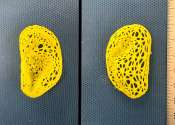Research team discovers new way to generate human cartilage
University of Montana researchers and their partners have found a new method to generate human cartilage of the head and neck. Mark Grimes, a biology professor in UM's Division of Biological Sciences, said they have induced ...
Apr 10, 2024
0
5









